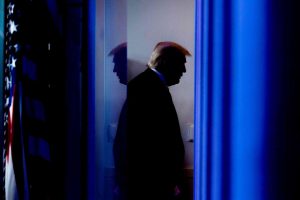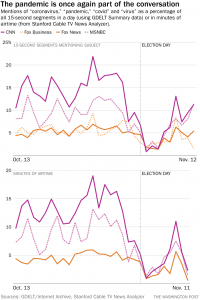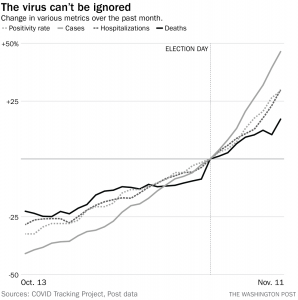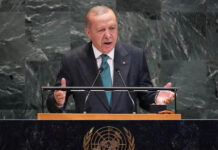NOVEMBER 12, 2020

President Trump departs after a coronavirus briefing at the White House on April 17, 2020. – Jim Watson/AFP/Getty Images
Every American wishes the coronavirus that emerged last year would simply go away, but no one wishes that more fervently and futilely than President Trump.
The last year of his term in office has been defined by the spread of the virus and the 240,000 deaths (to date) that have resulted. He saw and framed the virus’s arrival as an exogenous force that derailed his bid for reelection — a bid that was imperiled even before the virus arrived in the United States. His assertions that the virus would fade or vanish began early in the year and continued through Election Day.
His efforts to downplay it as something between innocuous and unimportant were apparently sincere, but they also allowed him to frame the pandemic as another way in which the media and Democrats were out to get him.
At a rally in Florida two days before Election Day, he claimed that efforts to contain the virus in states with Democratic governors would be eased once the election was over and that news coverage of the virus would similarly dissipate.
“You know what’s going to happen to [business closures]? On November 4th, the day after, they’re going to say, ‘All right, we’ll open up now,’ ” Trump said. “That’s why they’re locking down. But we’re going to have a safe vaccine that ends the pandemic. Without it, it’s rounding the — I say it’s — it drives them crazy. It’s rounding the turn. Because all they want to do, you turn and then there’s covid, covid, covid, covid, covid. We’d like to talk about covid, and then, next turn. Here’s what happens, November 4th, you won’t hear too much about it. You won’t hear too much about it.”
It is true that media coverage of the pandemic dropped a bit last week, a function of the increased coverage of the election and its aftermath. But coverage on the major cable news networks is by now back to where it was a month ago — with CNN and MSNBC spending more time on the subject than Fox News or sister network Fox Business.

This isn’t surprising, of course, given that the pandemic continues to rage across the country unabated. That is itself partly a function of Trump’s decision to downplay the coronavirus and to reject calls for stronger leadership on efforts to contain its spread.
Since Election Day nine days ago, the rate of positive tests nationally has jumped from 6.8 to 8.8 percent, according to the Covid Tracking Project. The rate of new confirmed cases is up 46 percent, and the number of people currently hospitalized with covid-19, the disease caused by the virus, is up nearly 30 percent. The number of covid-related deaths each day has risen 17 percent, with more than 10,000 people dying since Nov. 3.

Given these numbers, state leaders haven’t relaxed containment efforts; instead, they’ve increased them. The state of New York, a relative success story since it was hammered by the pandemic in the spring, introduced a new curfew meant to limit indoor interactions. The Republican governor of Utah ordered a statewide mask mandate, given the virus’s spread.
This entire thing is quite instructive about Trump’s approach to politics. His handling of the pandemic has unquestionably exacerbated its negative effects but largely exists outside of the context of partisan politics. But Trump, needing to rationalize his approach to the crisis, wrestled into his existing narrative about how everyone was out to get him — even as he waved away the risk it posed to similarly cast his response as the appropriate one.
Meanwhile, people kept getting sick and people kept winding up in the hospital and people kept dying. The virus was unaffected by the votes cast for or against Trump. It kept doing what it had been doing, taking advantage of people ignoring the advice on masks or recommendations about gathering in groups.
With more than 1,000 people dying every day and one out of every 390 Americans contracting the virus in the past week, the news media is still covering it. Much to Trump’s chagrin, the story was always about the virus and not about Trump.
Courtesy/Source: Washington Post




































































































